Assumption of Mary
The Assumption of Mary into Heaven (often shortened to the Assumption) is, according to the beliefs of the Catholic Church, Eastern Orthodox Churches and Oriental Orthodoxy,[3] among others, the bodily taking up of Mary, the mother of Jesus, into Heaven at the end of her earthly life.
| Assumption of Mary | |
|---|---|
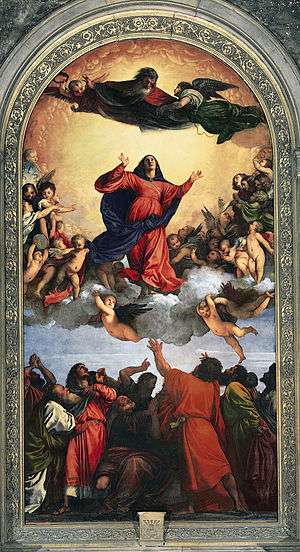 A famous treatment in Western art, Titian's Assumption, 1516–1518 | |
| Also called | |
| Observed by |
|
| Type | Christian |
| Significance | the bodily taking up of the Mary, mother of Jesus into Heaven |
| Observances | Attending mass or service |
| Date | August 15 |
| Frequency | annual |
In the churches that observe it, the Assumption is a major feast day, commonly celebrated on 15 August. In many countries, the feast is also marked as a Holy Day of Obligation in the Catholic Church.
The Catholic Church teaches as dogma that the Virgin Mary "having completed the course of her earthly life, was assumed body and soul into heavenly glory".[4] This doctrine was dogmatically defined by Pope Pius XII on 1 November 1950, in the apostolic constitution Munificentissimus Deus by exercising papal infallibility.[5] While the Catholic Church and Eastern Orthodox Church believe in the Dormition of the Mother of God (Dormition of the Theotokos or "the Falling Asleep of the Mother of God"),[6] whether Mary had a physical death has not been dogmatically defined. In Munificentissimus Deus (item 39) Pope Pius XII pointed to the Book of Genesis (3:15) as scriptural support for the dogma in terms of Mary's victory over sin and death through her intimate association with "the new Adam" (Christ)[7] as also reflected in 1 Corinthians 15:54: "then shall come to pass the saying that is written, Death is swallowed up in victory".[8][9][10]
The New Testament contains no explicit narrative about the death or dormition, nor of the Assumption of Mary, but several scriptural passages have been theologically interpreted to describe the ultimate fate in this and the afterworld of the Mother of Jesus (see below).[11] Various apocryphal documents do contain narrations of the event.
Etymology
The word "assumption" comes from the Middle English "assumpcioun" which means "a taking up into heaven", and from Latin "assumptio" which means "a taking".[12]
Doctrine
In 1950 Pope Pius XII invoked papal infallibility to define the dogma of the Assumption of the Blessed Virgin in his Apostolic Constitution Munificentissimus Deus:[13]
We proclaim and define it to be a dogma revealed by God that the immaculate Mother of God, Mary ever virgin, when the course of her earthly life was finished, was taken up body and soul into the glory of heaven.[14]
Munificentissimus Deus emphasised Mary's unity with her divine son and as his mother, she is the mother of his church which is his body; she is the "new Eve" (the term is used three times), paralleling Christ as the new Adam;[15] and by her assumption she has attained the final bodily resurrection promised to all Christians, and the Church has reached its ultimate salvation.[14] These three plus the Perpetual Virginity of Mary make up the four Marian dogmas of the Catholic church.
The dogma of the Assumption followed from the 1854 definition of Mary's Immaculate Conception (her freedom from original sin), and both developed from the recognition of her status as the Mother of God, meaning that she, like Jesus, was without sin, preserved from corruption, resurrected, received into heaven, and a recipient of corporeal glory.[15]
History
In the late 4th century, Epiphanius of Salamis wrote of his search for reliable traditions concerning the fate of Mary and his inability to discover any.[16] His inquiry suggests that discussion of Mary's immortality had already arisen in popular circles, and he identifies three beliefs concerning her end: that she died a normal and peaceful death; that she died a martyr; and that she did not die.[17] He suggested tentatively that Chapter 12 of the Book of Revelation, which speaks of a woman "clothed with the Sun" who escapes "the dragon" by fleeing into the wilderness to be nourished "for a time, and times, and half a time," might possibly be a reference to her immortality, but the early church identified the woman with the church and there is no evidence that an identification with Mary existed before Epiphanius.[16] "No one knows her end," he concludes.[17]
The Dormition/Assumption of Mary makes its first appearance in two apocryphal texts from the third and fourth centuries, the Liber Requiei Mariae ("Book of Mary's Repose"), and the "Six Books Dormition Apocryphon".[18] Both come from heterodox (i.e., proto-heretical) circles, the first having strong Gnostic overtones and the second associated with a sect called the Kollyridians, whom Epiphanius condemned for their excessive devotion to Mary.[18] Notable later apocrypha based on these include De Obitu S. Dominae and De Transitu Virginis, both probably from the 5th century, with further versions by Dionysius the Areopagite, and St Gregory of Tours, among others.[19] The Transitus Mariae was among apocrypha condemned in a 6th-century work called Decretum Gelasium (the "Decree of Gelasius", although not in fact by Pope Galasius I),[20] but by the early 8th century it was so well established that John of Damascus could set out what had become the standard Eastern tradition, that "Mary died in the presence of the Apostles, but that her tomb, when opened, upon the request of St Thomas, was found empty; wherefrom the Apostles concluded that the body was taken up to heaven."[21]
In some versions of the story, the event is said to have taken place in Ephesus, in the House of the Virgin Mary. This is a much more recent and localized tradition. The earliest traditions say that Mary's life ended in Jerusalem (see "Mary's Tomb"). By the 7th century, a variation emerged, according to which one of the apostles, often identified as St Thomas, was not present at the death of Mary but his late arrival precipitates a reopening of Mary's tomb, which is found to be empty except for her grave clothes. In a later tradition, Mary drops her girdle down to the apostle from heaven as testament to the event.[22] This incident is depicted in many later paintings of the Assumption.
Teaching of the Assumption of Mary became widespread across the Christian world, having been celebrated as early as the 5th century and having been established in the East by Emperor Maurice around AD 600.[23] St. John Damascene records the following:
St. Juvenal, Bishop of Jerusalem, at the Council of Chalcedon (451), made known to the Emperor Marcian and Pulcheria, who wished to possess the body of the Mother of God, that Mary died in the presence of all the Apostles, but that her tomb, when opened upon the request of St. Thomas, was found empty; wherefrom the Apostles concluded that the body was taken up to heaven.[24]
The Assumption of Mary was celebrated in the West under Pope Sergius I in the 8th century and Pope Leo IV confirmed the feast as official.[23] Theological debate about the Assumption continued, following the Reformation. But the people celebrated the Assumption as part of the cult of Mary that flourished from the Middle Ages. In 1950 Pope Pius XII defined it as dogma for the Catholic Church.[25] Catholic theologian Ludwig Ott stated, "The idea of the bodily assumption of Mary is first expressed in certain transitus-narratives of the fifth and sixth centuries. ... The first Church author to speak of the bodily assumption of Mary, in association with an apocryphal transitus of the B.M.V., is St. Gregory of Tours."[26] The Catholic writer Eamon Duffy states that "there is, clearly, no historical evidence whatever for it."[27] However, the Catholic Church has never asserted nor denied that its teaching is based on the apocryphal accounts. The Church documents are silent on this matter and instead rely upon other sources and arguments as the basis for the doctrine.
Catholic teaching
| Part of a series on the |
| Mariology of the Catholic Church |
|---|
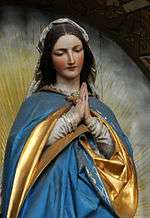 Virgo by Josef Moroder-Lusenberg |
|
|
|
|
|
|
Theological issues
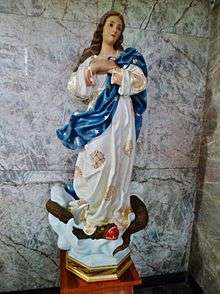
In Pius XII's dogmatic statement, the phrase "having completed the course of her earthly life", leaves open the question of whether the Virgin Mary died before her assumption or not. Mary's assumption is said to have been a divine gift to her as the 'Mother of God'. Ludwig Ott's view is that, as Mary completed her life as a shining example to the human race, the perspective of the gift of assumption is offered to the whole human race.[28]
Ludwig Ott writes in his book Fundamentals of Catholic Dogma that "the fact of her death is almost generally accepted by the Fathers and Theologians, and is expressly affirmed in the Liturgy of the Church", to which he adds a number of helpful citations. He concludes: "for Mary, death, in consequence of her freedom from original sin and from personal sin, was not a consequence of punishment of sin. However, it seems fitting that Mary's body, which was by nature mortal, should be, in conformity with that of her Divine Son, subject to the general law of death".[29]
The point of her bodily death has not been infallibly defined by any pope. Many Catholics believe that she did not die at all, but was assumed directly into Heaven. The dogmatic definition within the Apostolic Constitution Munificentissimus Deus which, according to Roman Catholic dogma, infallibly proclaims the doctrine of the Assumption leaves open the question of whether, in connection with her departure, Mary underwent bodily death. It does not dogmatically define the point one way or the other, as shown by the words "having completed the course of her earthly life".[25]
Scriptural basis
In Munificentissimus Deus, near the end of the review of the doctrine's history, Pope Pius XII stated : "All these proofs and considerations of the holy Fathers and the theologians are based upon the Sacred Writings as their ultimate foundation." Precedent to this, he cited many passages that have been offered in support of this teaching.
The pope cited 1 Corinthians 15. In this passage Paul alludes to Genesis 3:15 (in addition to the primary reference of Psalm 8:6), where it is prophesied that the seed of the woman will crush Satan with his feet: "I will put enmities between thee and the woman, and thy seed and her seed: she shall crush thy head, and thou shalt lie in wait for her heel." Since, then, Jesus arose to Heaven to fulfill this prophecy, it follows that the woman would have a similar end, since she shared this enmity with Satan.
The pope also mentioned (in paragraph 26) Psalm 132, a psalm commemorating the return of the Ark of God to Jerusalem and lamenting its subsequent loss. The second half of the psalm says that the loss will be recompensed in the New Covenant, and so it is hopefully prayed, "Arise, O Lord, into thy resting place: thou and the ark, which thou hast sanctified" (v. 8). Since the Church sees this New Covenant ark in Mary, it understands that she was taken into Heaven in the same manner as the Lord – that is, body and soul.
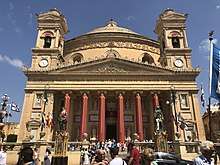
Finally, he mentioned in the next paragraph "that woman clothed with the sun [Revelation 12:1–2] whom John the Apostle contemplated on the Island of Patmos" was support for the defining of this dogmatic doctrine for Catholics.
Assumption v. Dormition
Many Catholics believe that Mary first died before being assumed, but they believe that she was miraculously resurrected before being assumed. Others believe she was assumed bodily into Heaven without first dying.[30][31] Either understanding may be legitimately held by Catholics, with Eastern Catholics observing the Feast as the Dormition.
Many theologians note by way of comparison that in the Catholic Church the Assumption is dogmatically defined, whilst in the Eastern Orthodox tradition the Dormition is less dogmatically than liturgically and mystically defined. Such differences spring from a larger pattern in the two traditions, wherein Catholic teachings are often dogmatically and authoritatively defined – in part because of the more centralized structure of the Catholic Church – whilst in Eastern Orthodoxy many doctrines are less authoritative.[32]
The Latin Catholic Feast of the Assumption is celebrated on 15 August and the Eastern Orthodox and Eastern Catholics celebrate the Dormition of the Mother of God (or Dormition of the Theotokos, the falling asleep of the Mother of God) on the same date, preceded by a 14-day fast period. Eastern Christians believe that Mary died a natural death, that her soul was received by Christ upon death, that her body was resurrected on the third day after her death and that she was taken up into heaven bodily in anticipation of the general resurrection.
Orthodox tradition is clear and unwavering in regard to the central point [of the Dormition]: the Holy Virgin underwent, as did her Son, a physical death, but her body – like His – was afterwards raised from the dead and she was taken up into heaven, in her body as well as in her soul. She has passed beyond death and judgement and lives wholly in the Age to Come. The Resurrection of the Body ... has in her case been anticipated and is already an accomplished fact. That does not mean, however, that she is dissociated from the rest of humanity and placed in a wholly different category: for we all hope to share one day in that same glory of the Resurrection of the Body that she enjoys even now.[33]
Protestant views
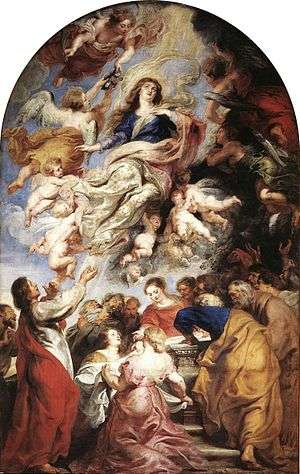
Views differ within Protestantism, with those with a theology closer to Catholicism sometimes believing in a bodily assumption whilst most Protestants do not.
Anglican views
Within Anglican doctrine the Assumption of Mary is either rejected or regarded as adiaphora ("a thing indifferent");[34] it therefore disappeared from Anglican worship in 1549, partially returning in some branches of Anglicanism during the 20th century under different names. A Marian feast on 15 August is celebrated by the Church of England as a non-specific feast of the Blessed Virgin Mary, a feast called by the Scottish Episcopal Church simply "Mary the Virgin",[35][36][37] and in the US-based Episcopal Church it is observed as the feast of "Saint Mary the Virgin: Mother of Our Lord Jesus Christ",[38] while other Anglican provinces have a feast of the Dormition[35] – the Anglican Church of Canada for instance marks the day as the "Falling Asleep of the Blessed Virgin Mary",[2]
The Anglican-Roman Catholic International Commission, which seeks to identify common ground between the two communions, released in 2004 a non-authoritative declaration meant for study and evaluation, the "Seattle Statement"; this "agreed statement" concludes that "the teaching about Mary in the two definitions of the Assumption and the Immaculate Conception, understood within the biblical pattern of the economy of hope and grace, can be said to be consonant with the teaching of the Scriptures and the ancient common traditions".[11]
Other Protestant views
The Protestant Reformer Heinrich Bullinger believed in the assumption of Mary. His 1539 polemical treatise against idolatry[39] expressed his belief that Mary's sacrosanctum corpus ("sacrosanct body") had been assumed into heaven by angels:
Hac causa credimus ut Deiparae virginis Mariae purissimum thalamum et spiritus sancti templum, hoc est, sacrosanctum corpus ejus deportatum esse ab angelis in coelum.[40] For this reason we believe that the Virgin Mary, Begetter of God, the most pure bed and temple of the Holy Spirit, that is, her most holy body, was carried to heaven by angels.[41]
Most modern Protestants neither teach nor believe in the Assumption of Mary, since they see no biblical basis or extra-biblical basis for it. Although many churches within Lutheranism do not teach the Assumption of Mary, 15 August remains a Lesser Feast in celebration of "Mary, Mother of Our Lord", according to the Calendar of Saints.[42][43]
Feasts
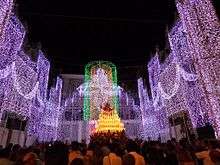
The Assumption is important to many Catholic and Eastern Orthodox Christians as the Virgin Mary's heavenly birthday (the day that Mary was received into Heaven). Belief about her acceptance into the glory of Heaven is seen by some Christians as the symbol of the promise made by Jesus to all enduring Christians that they too will be received into paradise. The Assumption of Mary is symbolised in the Fleur-de-lys Madonna.
The present Italian name of the holiday, "Ferragosto", may derive from the Latin name, Feriae Augusti ("Holidays of the Emperor Augustus"),[44] since the month of August took its name from the emperor. The Solemnity of the Assumption on 15 August was celebrated in the eastern Church from the 6th Century. The Catholic Church adopted this date as a Holy Day of Obligation to commemorate the Assumption of the Blessed Virgin Mary, a reference to the belief in a real, physical elevation of her sinless soul and incorrupt body into Heaven.
Public holidays

Assumption Day on 15 August is a nationwide public holiday in Andorra, Austria, Belgium, Burundi, Cameroon, Central African Republic, Chile, Republic of Congo, Côte d'Ivoire, Croatia, Colombia, Costa Rica, Cyprus, East Timor, France, Gabon, Greece, Georgia, Republic of Guinea, Haiti, Italy, Lebanon, Lithuania, Luxembourg, Republic of North Macedonia, Madagascar, Malta, Mauritius, Republic of Moldova, Monaco, Montenegro (Albanian Catholics), Paraguay, Poland (coinciding with Polish Army Day), Portugal, Romania, Rwanda, Senegal, Seychelles, Slovenia, Spain, Syria, Tahiti, Togo, and Vanuatu;[45] and was also in Hungary until 1948.
It is also a public holiday in parts of Germany (parts of Bavaria and Saarland) and Switzerland (in 14 of the 26 cantons). In Guatemala, it is observed in Guatemala City and in the town of Santa Maria Nebaj, both of which claim her as their patron saint.[46] Also, this day is combined with Mother's Day in Costa Rica and parts of Belgium.
Prominent Catholic, Eastern Orthodox, and Oriental Orthodox countries in which Assumption Day is an important festival but is not recognized by the state as a public holiday include the Czech Republic, Ireland, Mexico, the Philippines and Russia. In Bulgaria, the Feast of the Assumption is the biggest Eastern Orthodox Christian celebration of the Holy Virgin. Celebrations include liturgies and votive offerings. In Varna, the day is celebrated with a procession of a holy icon, and with concerts and regattas.[47]
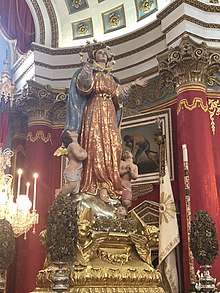
In many places, religious parades and popular festivals are held to celebrate this day. In Canada, Assumption Day is the Fête Nationale of the Acadians, of whom she is the patron saint. Some businesses close on that day in heavily francophone parts of New Brunswick, Canada. The Virgin Assumed in Heaven is also patroness of the Maltese Islands and her feast, celebrated on 15 August, apart from being a public holiday in Malta is also celebrated with great solemnity in the local churches especially in the seven localities known as the Seba' Santa Marijiet. The Maltese localities which celebrate the Assumption of Our Lady are: Il-Mosta, Il-Qrendi, Ħal-Kirkop, Hal-Ghaxaq, Il-Gudja, Ħ' Attard, L-Imqabba and Victoria. The hamlet of Praha, Texas holds a festival during which its population swells from approximately 25 to 5,000 people.
In Anglicanism and Lutheranism, the feast is now often kept, but without official use of the word "Assumption". In Eastern Orthodox churches following the Julian Calendar, the feast day of Assumption of Mary falls on 28 August.
Art
The earliest known use of the Dormition (or Assumption - the two terms will be used interchangeably in this section) as a subject for Christian art is found on a sarcophagus in the crypt of a church in Zaragoza in Spain dated c.330.[19] It became a popular subject in Western Christian art, and especially after the Reformation, when it was used to refute the Protestants and their downplaying of Mary's role in salvation.[48] Angels commonly carry her heavenward where she is to be crowned by Christ, while the Apostles below surround her empty tomb as they stare up in awe.[48] Caravaggio, the "father" of the Baroque movement, caused a stir by depicting her as a decaying corpse, quite contrary to the doctrine promoted by the Church;[49] more orthodox examples include works by El Greco, Rubens, Annibale Caracci, and Nicholas Poussin, the last replacing the Apostles with putti throwing flowers into the tomb.[48]
See also
- Assumption (disambiguation), a disambiguation page which includes many places named after the Assumption of Mary
- Cathedral of the Assumption (disambiguation)
- Assumption of Mary, patron saint archive
- Ascension of Jesus
- Immaculate Conception
- Perpetual Virginity of Mary
References
Citations
- Episcopal Advance. 99–101. Episcopal Diocese of Chicago. February 1970.
On the fifteenth of August, the Feast of Saint Mary the Virgin, Mother of Our Lord Jesus Christ, the Episcopal Church prays: "O God, you have taken to yourself the blessed Virgin Mary, mother of your incarnate Son: Grant that we, who have been redeemed by his blood, may share with her the glory of your eternal kingdom; through Jesus Christ our Lord, who lives and reigns with you, in the unity of the Holy Spirit, one God, now and for ever. Amen.
- "The Calendar". Prayerbook.ca. p. ix. Archived from the original on 4 November 2013. Retrieved 3 November 2013.
- Church of England (1907). The Annotated Book of Common Prayer: An Historical, Ritual, and Theological Commentary on the Devotional System of the Church of England. Longmans, Green and Company. p. 159. Retrieved 15 August 2015.
- Pope Pius XII: "Munificentissimus Deus – Defining the Dogma of the Assumption" Archived 4 September 2013 at the Wayback Machine, par. 44. Vatican, 1 November 1950
- Encyclopedia of Catholicism by Frank K. Flinn, J. Gordon Melton 207 ISBN 0-8160-5455-X p. 267
- Munificentissimus Deus, 17 Archived 4 September 2013 at the Wayback Machine In the liturgical books which deal with the feast either of the dormition or of the Assumption of the Blessed Virgin there are expressions that agree in testifying that, when the Virgin Mother of God passed from this earthly exile to heaven, what happened to her sacred body was, by the decree of divine Providence, in keeping with the dignity of the Mother of the Word Incarnate, and with the other privileges she had been accorded.
- http://w2.vatican.va/content/pius-xii/en/apost_constitutions/documents/hf_p-xii_apc_19501101_munificentissimus-deus.html
- Introduction to Mary by Mark Miravalle (1993) Queenship Pub. Co. ISBN 978-1-882972-06-7 pp. 75–78
- Paul Haffner in Mariology: A Guide for Priests, Deacons, seminarians, and Consecrated Persons (2008) ISBN 9781579183554 edited by M. Miravalle, pp. 328–350
- Apostolic Constitution Munificentissimus Deus item 39at the Vatican web site Archived 4 September 2013 at the Wayback Machine
- "Mary: Grace and Hope in Christ". Vatican.va. 26 June 2000. Retrieved 3 November 2013.
There is no direct testimony in Scripture concerning the end of Mary’s life. However, certain passages give instances of those who follow God's purposes faithfully being drawn into God's presence. Moreover, these passages offer hints or partial analogies that may throw light on the mystery of Mary's entry into glory.
- WEBSTER'S DICTIONARY, 1913.
- Dustin Resch (8 April 2016). Barth's Interpretation of the Virgin Birth: A Sign of Mystery. Routledge. p. 171. ISBN 978-1-317-17611-4.
- Collinge 2012, p. 53.
- Kerr 2001, p. 746.
- Shoemaker 2002, p. 11-12.
- Shoemaker 2002, p. 14.
- Shoemaker 2006, p. unpaginated.
- Zirpolo 2018, p. 213.
- Shoemaker 2002, p. 17 and fn 27.
- Jenkins 2015, p. unpaginated.
- Ante-Nicene Fathers – The Writings of the Fathers Down to A.D. 325, vol. 8 page 594
- Butler's Lives of the Saints by Alban Butler, Paul Burns 1998 ISBN 0860122573 pp. 140–141
- More on the Assumption of Mary by Fr. William Saunders, EWTN
- "Apostolic Constitution Munificentissimus Deus, no 44". Vatican.va. Archived from the original on 4 September 2013. Retrieved 3 November 2013.
- Ludwig Ott, Fundamentals of Catholic Dogma (Rockford: Tan, 1974), pp. 209–210
- Eamon Duffy, What Catholics Believe About Mary (London: Catholic Truth Society, 1989), p. 17
- Ludwig Ott's Fundamentals of Catholic Dogma, pp. 250 ff.
- Fundamentals of Catholic Dogma, Ludwig Ott, Book III, Pt. 3, Ch. 2, §6, ISBN 0-89555-009-1
- The Catholicism Answer Book: The 300 Most Frequently Asked Questions by John Trigilio, Kenneth Brighenti 2007 ISBN 1-4022-0806-5 p. 64
- Shoemaker 2006, p. 201
- See "Three Sermons on the Dormition of the Virgin" by John of Damascus, from the Medieval Sourcebook
- Bishop Kallistos (Ware) of Diokleia, in: Festal Menaion [London: Faber and Faber, 1969], p. 64.
- Williams, Paul (2007). pp. 238, 251, quote: "Where Anglican writers discuss the doctrine of the Assumption, it is either rejected or held to be of the adiaphora."
- Williams, Paul (2007). p. 253, incl. note 54.
- The Church of England, official website: The Calendar. Accessed 17 July 2018
- The Scottish Episcopal Church, official website: Calendar and Lectionary. Accessed 17 July 2018
- The Episcopal Church. "Saint Mary the Virgin: Mother of Our Lord Jesus Christ". Liturgical Calendar. New York: The Domestic and Foreign Missionary Society, The Episcopal Church. Retrieved 17 July 2018.
- De origine erroris libri duo (On the Origin of Error, Two Books) . "In the De origine erroris in divorum ac simulachrorum cultu he opposed the worship of the saints and iconolatry; in the De origine erroris in negocio Eucharistiae ac Missae he strove to show that the Catholic conceptions of the Eucharist and of celebrating the Mass were wrong. Bullinger published a combined edition of these works in 4 ° (Zurich 1539), which was divided into two books, according to themes of the original work." The Library of the Finnish nobleman, royal secretary and trustee Henrik Matsson (c. 1540–1617), Terhi Kiiskinen Helsinki: Academia Scientarium Fennica (Finnish Academy of Science), 2003, ISBN 951-41-0944-9, 9789514109447, p. 175
- Froschauer. De origine erroris, Caput XVI (Chapter 16), p. 70
- The Thousand Faces of the Virgin Mary (1996), George H. Tavard, Liturgical Press ISBN 0-8146-5914-4, 9780814659144, p. 109.
- "Mary, Mother of Our Lord". Liturgybytlw.com. Retrieved 3 November 2013.
- "St. Mary, Mother of Our Lord". Wmltblog.org. 15 August 2011. Archived from the original on 15 June 2013. Retrieved 3 November 2013.
- Pianigiani, Ottorino (1907). "Vocabolario etimologico della lingua italiana".
- Columbus World Travel Guide, 25th Edition
- "Reiland, Catherine. "To Heaven Through the Streets of Guatemala City: the Processions of the Virgin of the Assumption", Emisferica". Archived from the original on 22 December 2016. Retrieved 11 June 2018.
- "The Assumption of Mary into Heaven, the most revered summer Orthodox Christian feast in Bulgaria", Radio Bulgaria, August 18, 2018
- Zirpolo 2018, p. 83.
- Zirpolo 2018, p. 213-214.
Bibliography
- Boss, Sarah Jane (2000). Empress and Handmaid: On Nature and Gender in the Cult of the Virgin Mary. A&C Black. ISBN 9780304707812.CS1 maint: ref=harv (link)
- Collinge, William J. (2012). Historical Dictionary of Catholicism. Scarecrow Press. ISBN 9780810879799.CS1 maint: ref=harv (link)
- Ford, John T. (2006). Saint Mary's Press Glossary of Theological Terms. Saint Mary's Press. ISBN 9780884899037.CS1 maint: ref=harv (link)
- Jenkins, Philip (2015). The Many Faces of Christ. Hachette. ISBN 9780465061617.CS1 maint: ref=harv (link)
- Kerr, W.N. (2001). "Mary, Assumption of". In Elwell, Walter A. (ed.). Evangelical Dictionary of Theology. Baker Academic. ISBN 9780801020759.CS1 maint: ref=harv (link)
- Shoemaker, Stephen J. (2006). Mary in Early Christian Faith and Devotion. Yale University Press. ISBN 9780300219531.CS1 maint: ref=harv (link)
- Shoemaker, Stephen J. (2002). Ancient Traditions of the Virgin Mary's Dormition and Assumption. Oxford University Press. ISBN 9780199250752.CS1 maint: ref=harv (link)
- Williams, Paul (2019). "The English Reformers and the Blessed Virgin Mary". In Maunder, Chris (ed.). The Oxford Handbook of Mary. Oxford University Press. ISBN 9780198792550.CS1 maint: ref=harv (link)
- Zirpolo, Lilian H. (2018). Historical Dictionary of Baroque Art and Architecture. Rowman & Littlefield. ISBN 9781538111291.CS1 maint: ref=harv (link)
Further reading
- Duggan, Paul E. (1989). The Assumption Dogma: Some Reactions and Ecumenical Implications in the Thought of English-speaking Theologians. Emerson Press, Cleveland, Ohio.
- Mimouni, Simon Claude (1995). Dormition et assomption de Marie: Histoire des traditions anciennes. Beauchesne, Paris.
- Salvador-Gonzalez, José-María (2019). "Musical Resonanes in the Assumption of Mary and Their Reflection in the Italian Trecento and Quattrocento Painting". Music in Art: International Journal for Music Iconography. 44 (1–2): 79–96. ISSN 1522-7464.
External links
| Wikimedia Commons has media related to Assumption of Mary. |
- "Munificentissimus Deus – Defining the Dogma of the Assumption" Vatican, 1 November 1950
- Footage of the Assumption proclamation (1950) (British Pathé)
- "De Obitu S. Dominae". Uoregon.edu. Archived from the original on 31 August 2009. Retrieved 3 November 2013.
- "De Transitu Virginis". Uoregon.edu. Archived from the original on 13 April 2009. Retrieved 3 November 2013.
.jpg)
